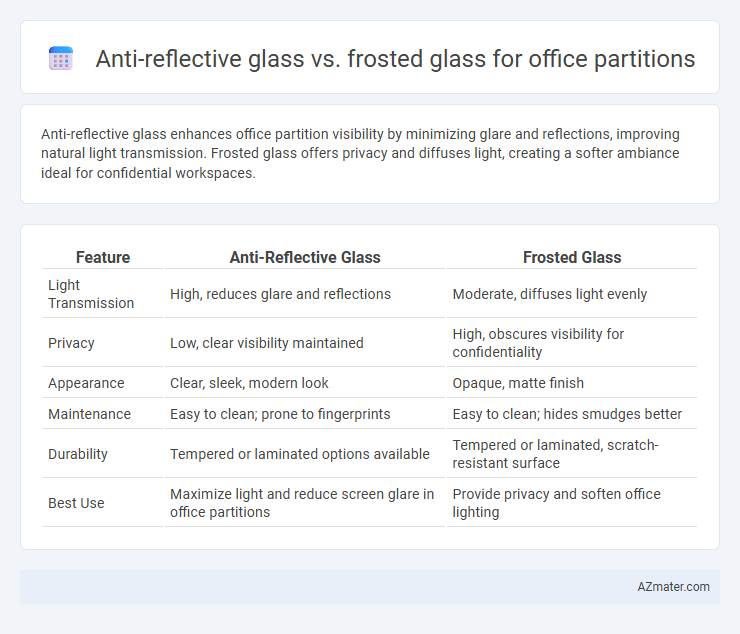Anti-reflective glass enhances office partition visibility by minimizing glare and reflections, improving natural light transmission. Frosted glass offers privacy and diffuses light, creating a softer ambiance ideal for confidential workspaces.
Table of Comparison
| Feature | Anti-Reflective Glass | Frosted Glass |
|---|---|---|
| Light Transmission | High, reduces glare and reflections | Moderate, diffuses light evenly |
| Privacy | Low, clear visibility maintained | High, obscures visibility for confidentiality |
| Appearance | Clear, sleek, modern look | Opaque, matte finish |
| Maintenance | Easy to clean; prone to fingerprints | Easy to clean; hides smudges better |
| Durability | Tempered or laminated options available | Tempered or laminated, scratch-resistant surface |
| Best Use | Maximize light and reduce screen glare in office partitions | Provide privacy and soften office lighting |
Introduction to Office Glass Partitions
Office glass partitions enhance workspace aesthetics and functionality by providing transparency, light diffusion, and sound control. Anti-reflective glass minimizes glare and reflections, improving visual comfort for employees working with computer screens, while frosted glass offers privacy by obscuring visibility without sacrificing natural light. Choosing between these materials depends on the desired balance of privacy, light transmission, and visual clarity in modern office design.
What is Anti-Reflective Glass?
Anti-reflective glass is specially engineered to minimize glare and reflections by applying ultra-thin coatings that enhance light transmission, making it ideal for office partitions where clear visibility and reduced eye strain are critical. This type of glass improves screen clarity and visual comfort compared to traditional glass or frosted glass, which obscures visibility by diffusing light. Choosing anti-reflective glass in office environments promotes transparency and daylight efficiency while maintaining a modern aesthetic and functional workspace.
Understanding Frosted Glass for Offices
Frosted glass for office partitions provides privacy while allowing natural light to diffuse throughout the space, reducing glare and maintaining an open atmosphere. Its textured surface obscures visibility without compromising brightness, making it ideal for meeting rooms and private workstations where confidentiality is essential. Unlike anti-reflective glass, frosted glass also minimizes fingerprints and smudges, contributing to easier maintenance in high-traffic office environments.
Key Differences Between Anti-Reflective and Frosted Glass
Anti-reflective glass minimizes glare and reflections, enhancing visibility and clarity in office partitions, while frosted glass offers privacy by diffusing light and obscuring views. Anti-reflective glass typically features a smooth, transparent surface with special coatings, whereas frosted glass has a textured or sandblasted finish that scatters light. Choosing between them depends on the need for clear sightlines versus privacy, with anti-reflective glass suited for open, collaborative spaces and frosted glass ideal for confidential or partitioned work areas.
Light Transmission and Visibility Comparison
Anti-reflective glass offers superior light transmission, often exceeding 90%, allowing natural light to permeate office spaces while minimizing glare and reflections, which enhances visibility and visual comfort. Frosted glass typically transmits between 70% to 85% of light, diffusing light to create privacy by obscuring detailed visibility, making it ideal for areas requiring discreet separation. When choosing between the two for office partitions, anti-reflective glass maximizes transparency and clarity, whereas frosted glass prioritizes privacy with softened visibility and reduced light intensity.
Privacy Levels: Which Glass Performs Better?
Anti-reflective glass offers moderate privacy by reducing glare and minimizing reflections, making it suitable for offices that require visual clarity alongside some privacy. Frosted glass provides higher privacy levels by obscuring visibility completely, ensuring confidential discussions remain unseen while still allowing light diffusion. For offices prioritizing maximum privacy in partitions, frosted glass outperforms anti-reflective glass in minimizing visual distractions and protecting sensitive information.
Aesthetic Appeal and Design Flexibility
Anti-reflective glass offers superior clarity and transparency, enhancing natural light flow and creating a sleek, modern office aesthetic. Frosted glass provides privacy while allowing soft light diffusion, adding a textured design element that complements various interior styles. Both materials deliver design flexibility, with anti-reflective glass suited to open, airy environments and frosted glass ideal for creating discrete, stylish partitions.
Durability and Maintenance Considerations
Anti-reflective glass offers superior durability with its scratch-resistant coating, making it ideal for high-traffic office partitions requiring minimal maintenance to retain clarity. Frosted glass, while aesthetically pleasing and providing privacy, may show wear more quickly due to surface etching and can be harder to clean, often requiring specialized treatments to maintain its matte finish. Choosing between the two depends on balancing the need for long-lasting transparency and ease of upkeep versus desired privacy and design preferences.
Cost Comparison: Anti-Reflective vs Frosted Glass
Anti-reflective glass for office partitions tends to have a higher upfront cost compared to frosted glass due to specialized coatings that reduce glare and improve clarity. Frosted glass is generally more affordable, offering privacy with a matte finish created through sandblasting or acid etching, making it cost-effective for budget-conscious projects. Long-term maintenance costs for anti-reflective glass may be slightly higher because of its delicate surface treatments, while frosted glass requires minimal upkeep, enhancing its cost efficiency.
Choosing the Right Glass for Your Office Partition
Choosing the right glass for your office partition depends on balancing privacy, light transmission, and aesthetics. Anti-reflective glass reduces glare and enhances clarity, making it ideal for bright office environments where clear communication and visual openness are essential. Frosted glass offers superior privacy by obscuring visibility while still allowing natural light to permeate, suitable for confidential meeting rooms or personal workspaces.

Infographic: Anti-reflective glass vs Frosted glass for Office partition
 azmater.com
azmater.com